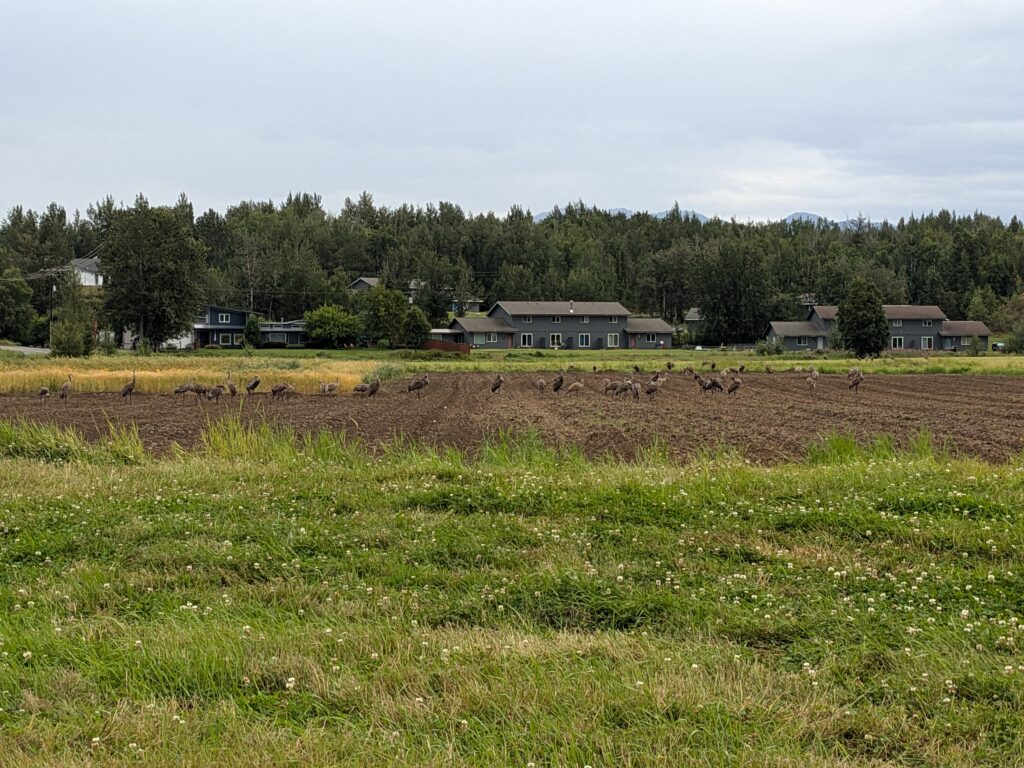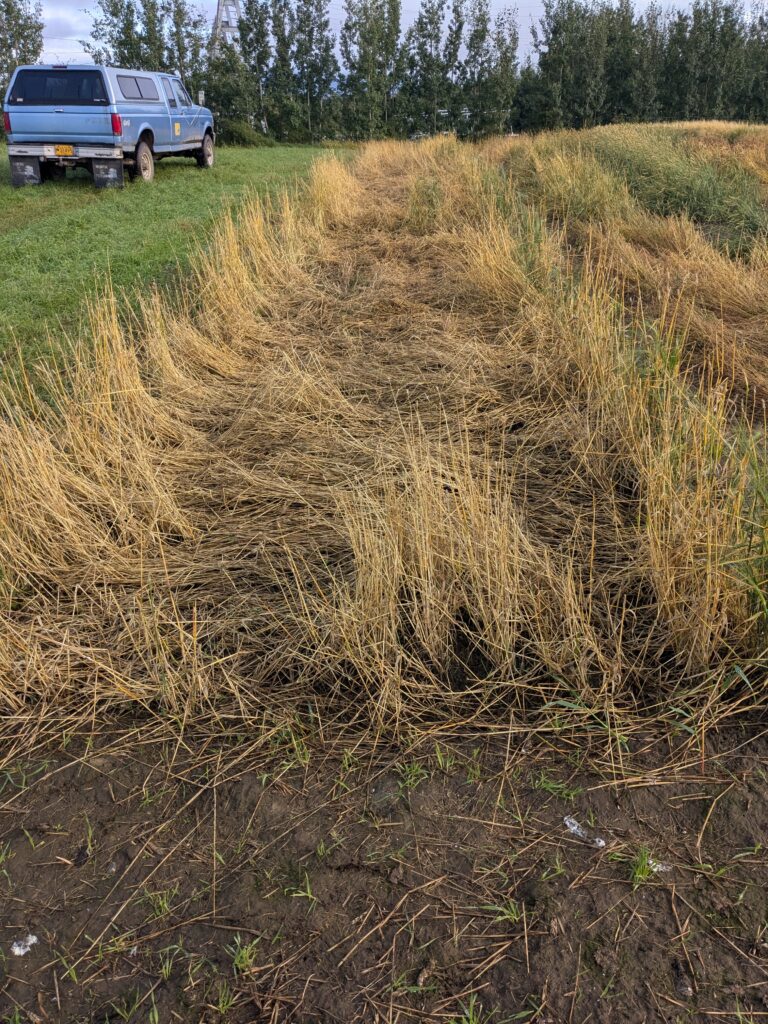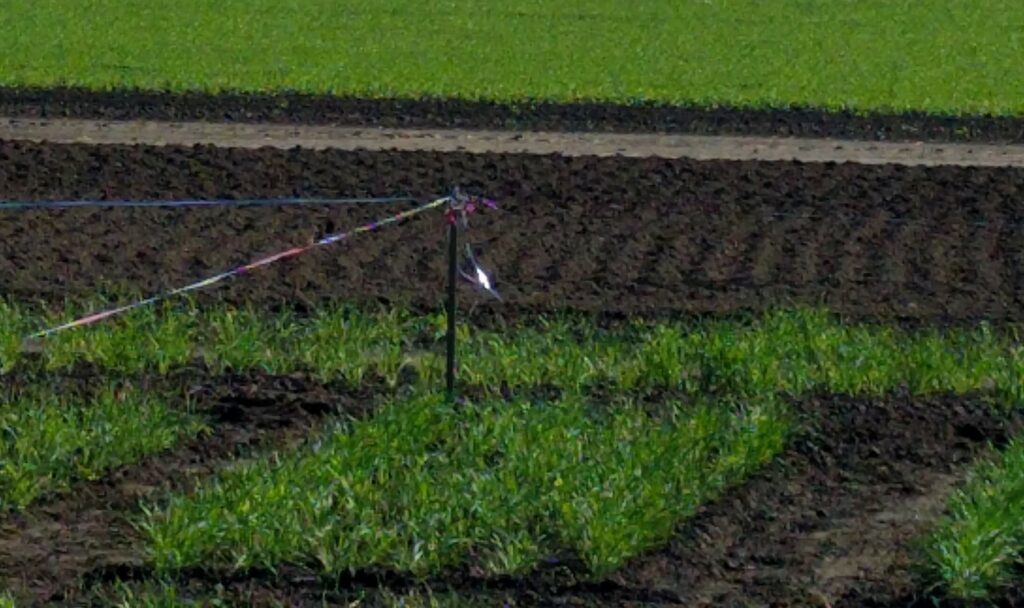
During every spring and fall migration there are always large flocks of Sandhill Cranes at the Matanuska Experiment Farm. For years, folks have stopped along Georgeson Drive (the old Trunk Rd) to observe and take photos of them in the fields. They are an awesome bird, often invoking thoughts of something prehistoric considering their size, wingspan and their call —today’s version of a pterosaur?
However, for those who have conducted research at the Matanuska Experiment Farm and Extension Center (and the Fairbanks Experiment Farm and the Delta Junction Field Research Site), Sandhill Cranes can be a serious pest. This isn’t a new phenomenon, but rather has been a problem ever since the establishment of the experiment farms over 100 years ago. After all, the cranes were here before the experiment farms were established. Once the birds found out that there was a new food source here they would stop over in the spring on their way north to nest and again in the fall on their way south for the winter.
In the spring migration, they would eat newly planted grain crops, preferring the seed through germination and the first true leaf. Notice all the tracks in the photo showing the crane damage in a spring planted plot. After the first true leaf has developed all the way towards maturity (in agronomic terms, the milk to soft dough growth stages) they would leave the crop alone. In the fall migration, they prefer mature to ripe grain crops (hard dough to ripe growth stages), leaving any late forming grain heads alone (late tillers). In addition to the large migratory flocks in the spring and fall, there are always a few juvenile cranes that haven’t mated up yet that hang around all summer. These birds leave the agronomic crops alone, preferring instead to go after insects in the hay fields.

Considering the relatively small research and demonstration plot size of 180 square feet, it doesn’t take very many cranes to cause significant damage. In the spring, a couple of cranes will walk down each row, pecking out the recently planted and newly germinated seeds. In the fall, these same couple of birds will peck out mature and ripe seeds directly from the seed head, flattening everything as they work their way down the rows. So, even the crops they don’t eat right away are now on the ground and not harvestable.

If the loss occurs in the spring, plots can be replanted once the main flock has moved on. However, if the loss occurs in the fall, then the data from those plots is lost. The loss of a few plots in one replication doesn’t have a huge impact on a research study. After all, this is one reason why we have multiple replications in a research project and we conduct the study over multiple years. However, if the crane population is large enough in the fall, an entire research study can be wiped out overnight. We might not be able to do a combine harvest unless the weather and crop growth stage are just right, (2 to 3 days of dry weather in a row and the crop is at hard dough or ripe growth stage). The cranes, on the other hand, will eat any day and all day long regardless of the weather.

So, how to control these pests? We have tried a number of different methods over the years. Some with a great deal of success and some not so much. Things like scarecrows, scare balloons and even a parked truck are stationary and are not very effective once the birds figure out that these non-mobile objects offer no threat. We’ve hired handlers with dogs and raptors to harass the birds, which works great, but only as long as they are present. A remote-controlled model plane in the shape of an eagle also worked great, but only if it was around. The same effect happens with those of us employees working in the fields during the day. Once everyone goes home, the birds come back.
The one method that really works is a propane scare cannon. A small propane tank is hooked up to the device and set to go off with a loud bang every 15 to 30 minutes. Unfortunately, in addition to scaring off the cranes, it really angers everyone who lives anywhere close enough to hear that loud bang all day and night long. So, we don’t use those either.
Currently, we use sparkle tape. This is a plastic ribbon with a shiny red side and a shiny silver side. The tape is tied on stakes that are about Sandhill Crane head high and twisted between stakes, so that it flashes as the wind blows. That flashing action is supposed to scare the birds away. To make this method effective, you have to set up the sparkle tape in relatively small squares, around every 10 plots or so. Anything larger than that and they will just fly inside the square. The sparkle tape seems to be more effective in the spring rather than the fall. This is probably due to the fact that the crops are taller than the stakes holding the sparkle tape in the fall, so the cranes only see one side of the square at a time. Still, it is better than nothing.

The other method that also works well is to plant a grain drill strip or more of sacrificial barley around the research and demonstration study plots. The research plots are planted with a cone seeder which plants 6 rows at about 7 inches apart around a 4 foot wide plot with about 2 feet of space on either side between the adjacent plots. There are ideal conditions for data collection, but also ideal to attract cranes to eat those crops. Planting a strip of sacrificial barley around the outside of the study area with a grain drill surrounds the study area with a continuous wall of barley that is 10 feet wide. With sparkle tape around plots and nothing around the drill strips, the cranes congregate in the drill strips to eat, leaving the plots alone (mostly). Here again, the effectiveness of this method is dependent on the weather and the population of cranes. If the weather isn’t right for a combine harvest and the number of cranes are high enough, they will eat through the drill strips quickly and start in on the study area. There are a couple of photos showing “before” and “after” cranes have been working the drill strips. Notice that in the “after” photo, not only has the drill strip been consumed, so has the first plot of wheat next to it. So, to help the effectiveness of this method, additional drill strips are planted in the fall in an area away from the main research fields, like the next field over. The cranes are attracted to newly planted seed and will congregate there instead of at the research field. All of which hopefully buys us some time to actually get a harvest off the research plots.
At the Fairbanks Experiment Farm a new laser bird scare device is being tested. It uses a green laser that sweeps back and forth over the plot area at set time intervals. The birds are supposed to be scared away as the laser approaches. It will be interesting to see how well this device works before we get some for the Matanuska Experiment Farm.
If the general public wishes to view the cranes in the fields, please respect the signs that limit access to authorized employees only, remain on the outside of the fences, don’t climb over the gates, keep your dogs on a leash, and stay out of the fields. Be aware that Georgeson Drive has a fair amount of traffic and farm equipment use as well as little to no shoulders. Rather than parking along the road, park in the KinWin Trailhead Parking Lot nearby and walk to the fence line to view the cranes.
By Bob Van Veldhuizen, Agronomy Research Assistant, rmvanveldhuizen@alaska.edu